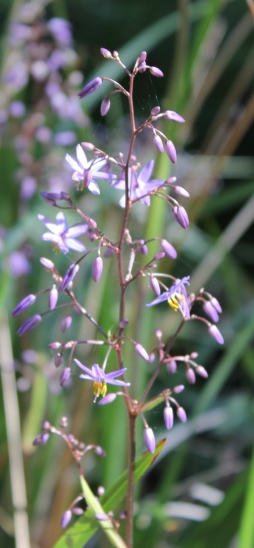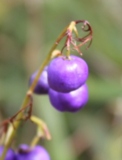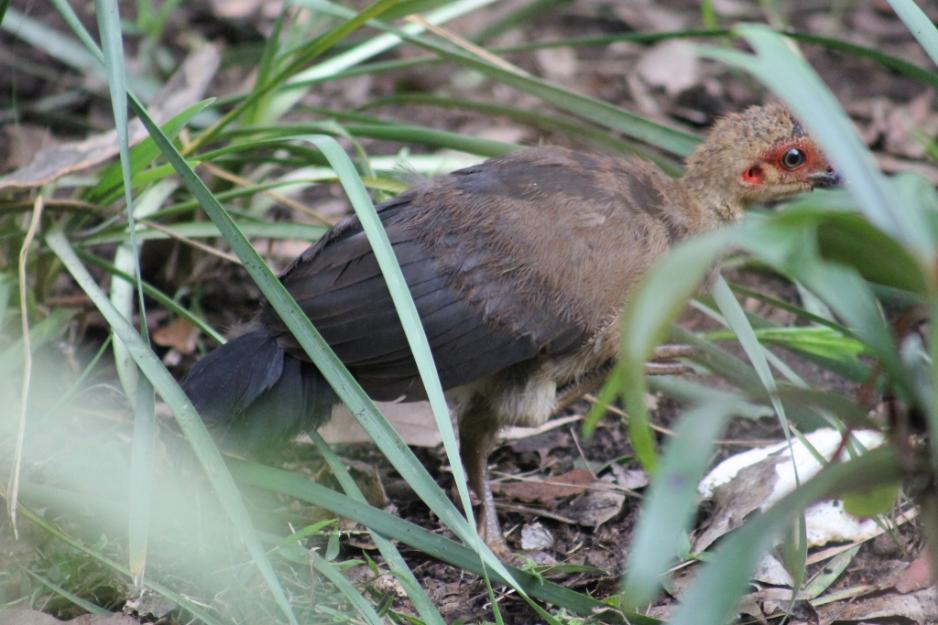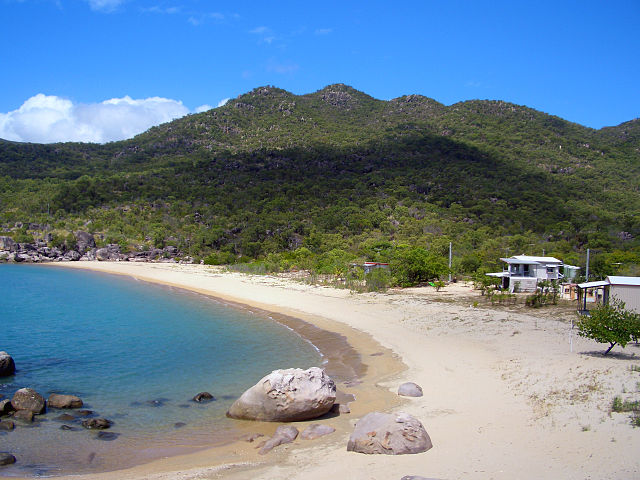November 25 - December 1, 2012: Issue 86
Pittwater Plants- Blue Flax Lily, Dianella caerulea
 Dianella
caerulea, commonly known as the Blue flax-lily, blueberry lily, or paroo lily,
is a perennial herb of the family Xanthorrhoeaceae, subfamily
Hemerocallidoideae, which grows across the eastern states of Australia and
Tasmania. It is a herbaceous strappy perennial plant to a metre high, with dark
green blade-like leaves to 70 cm long. Blue flowers appear in Spring and Summer
and are followed by indigo-coloured berries. It was first described by English
taxonomist John Sims in Curtis's Botanical Magazine in 1802. Its specific name
is the Latin adjective caerulea "blue". The genus name is derived from the Roman
goddess Diana, with a diminutive suffix -ella. Dianella caerulea is highly
variable species, with many forms found throughout eastern Australia. Six
varieties are known from the Sydney district alone and there are 19 species
across
Dianella
caerulea, commonly known as the Blue flax-lily, blueberry lily, or paroo lily,
is a perennial herb of the family Xanthorrhoeaceae, subfamily
Hemerocallidoideae, which grows across the eastern states of Australia and
Tasmania. It is a herbaceous strappy perennial plant to a metre high, with dark
green blade-like leaves to 70 cm long. Blue flowers appear in Spring and Summer
and are followed by indigo-coloured berries. It was first described by English
taxonomist John Sims in Curtis's Botanical Magazine in 1802. Its specific name
is the Latin adjective caerulea "blue". The genus name is derived from the Roman
goddess Diana, with a diminutive suffix -ella. Dianella caerulea is highly
variable species, with many forms found throughout eastern Australia. Six
varieties are known from the Sydney district alone and there are 19 species
across  Australia.
Australia.
They will attract fruit-eating birds and butterflies in gardens. These lovely blue fruits were eaten raw by the Cadigal peoples and are said to have a sweet flavour which becomes nutty once the seeds are chewed. These berries are high in Vitamin C. The leaves were used to make a strong fibre that is woven into baskets. Photos by A J Guesdon.

Reproduction of an image that appeared in The Botanical Magazine vol. 15. no. 505 (1801). The title is Dianella caerulea.Blue Dianella. It depicts the plant species Dianella caerulea. Date 1801
December 2 - 8, 2012: Issue 87
Baby Birds In Our Backyards - Bush Turkey Fledgling

This young Bush Turkey was scratching around in our backyard on Friday afternoon. This year's birds are leaving their nests now to wander further afield. Although these birds grow quite large this one was only half a handful in size. Please keep your own animals leashed if a canine when out and about and bring all felines inside at night to protect our native wildlife. Photo by A J Guesdon.
December 9 - 15, 2012: Issue 88
Palm Beach Sand Dune Project Receives High Commendation Award
 Huskisson Beach, Wollongong, has taken out the overall State Award for the cleanest beach in NSW as part of Sydney Waters 2012 Clean beaches awards. North Palm Beach SLSC members and local volunteers from the community have received a high commendation for their own dune restoration and regeneration project at the Keep Australia Beautiful Sydney Water 2012 Clean Beaches - Connecting Our Coast Awards held at Coledale SLSC in Wollongong on 26 November 2012. The Project targeted protecting and preserving the beach and sand dune from erosion and protecting native plant species.
Huskisson Beach, Wollongong, has taken out the overall State Award for the cleanest beach in NSW as part of Sydney Waters 2012 Clean beaches awards. North Palm Beach SLSC members and local volunteers from the community have received a high commendation for their own dune restoration and regeneration project at the Keep Australia Beautiful Sydney Water 2012 Clean Beaches - Connecting Our Coast Awards held at Coledale SLSC in Wollongong on 26 November 2012. The Project targeted protecting and preserving the beach and sand dune from erosion and protecting native plant species.
Michael Tancred, a North Palm Beach SLSC member who has led the project for five years, praised the work of Pittwater Council Landscape Architect Mark Eriksson and Pittwater Council Bushcare Officer Lavinia Schofield in identifying how to rebuild and regenerate these popular sand dunes. He also spoke of the hard work of Pittwater Council staff member Matt Hansen in preparing all the required paperwork and securing the grant.
Clean Beaches is a program run by Keep Australia Beautiful. Launched in 1998, Clean Beaches identifies the champions of our coasts who are taking action and caring for a beach or foreshore through:
litter prevention initiatives
resource recovery and waste management
environmental innovation and protection
water conservation
sustainable energy management; and
heritage and culture preservations
At Palm Beach Surf Club members and volunteers removed existing fencing, removed weeds and fixed the drainage problem in order to re-profile the sand dune and promote revegetation of 8800 native plants with the help of funding provided by a ‘Caring for our Country’. This was the second Grant secured by Pittwater Council to further this work. The North Palm Beach Dune Group meets every third Saturday of the month (next is 16.12.2012 – meet at 9am at the Surf Club).
Michael Tancred said recently, "Next year we are going to go for even bigger award categories as we are really working to reduce our carbon footprint. In addition to the Dune Restoration and Regeneration Project, we also run the club on solar power and use a recycled water system".
The award plaque will be placed in the North Palm Bach SLSC which is currently undergoing renovations, with the addition of another storey and new walls.
Michael said on Friday “The recognition is good because it acknowledges all the effort people put in. It may also encourage others to join in. Any extra hands are always welcome. "
A State Winners Breakfast was held on Thursday morning (6.12.2012) at Dunes Restaurant and Kiosk, Palm Beach, to further acknowledge all awards participants.
Picture at top: North Palm Beach Dunes by A J Guesdon.
December 30, 2012 - January 5, 2013: Issue 91
Top Australian Environmental Stories of 2012
Good:
Australia creates world's biggest marine protected
areas
Australia announced it would establish the world's
largest network of marine protected areas, spanning 3.1 million square
kilometers (1.19 million square miles). The announcement means our maine parks
will increase the number of its marine reserves from 27 to 60, putting nearly 40
percent of Australian waters under some form of protection. The plan also set
aside a part of the Coral Sea, which includes the Great Barrier Reef, for
protection. The new marine protected areas include bans on oil and gas mining
and tougher regulations on fisheries. Marine scientists have become increasingly
vocal that oceanic biodiversity is imperilled by a combination of overfishing,
nutrient pollution, ocean acidification and climate change. Fisher industries
state this is the death knell for their livelihood and associated suppliers of
services and products.
Australia Legislates to introduce
carbon tax - July, 2012
Australian Federal Government
announces it will introduce a carbon tax that targets around 300 of the
country's biggest polluters. The tax started out at around $24 for every metric
ton of carbon pollution, aiming to cut carbon by 159 million metric tons in
eight years. The Clean Energy Act establishing the tax was hugely opposed by
Australia's opposition government which warns it will repeal the tax if they
gain power. The Australian public is wary, citing any increase by any government
on big industry players is immediately passed on to consumers, thus negating any
positive results. Time will tell how effective this tax is.
Stopping Super Trawler from plundering Australian fish stocks.
Australia passes legislation against illegal timber imports – November 2012, joining the U.S. in outlawing the importation of illegal logged timber from abroad. The new legislation makes it a criminal offence for Australian businesses to import timber from illegal operations. The Australian government estimates that $400 million worth of illegal timber products are sold in the country each year often as outdoor furniture and wood for decks. The law was pushed by a wide coalition of businesses, environmental groups, and social and religious organizations.
Bad:
Australian coal seam gas exploiters is among the environmental stories of the year, as gas companies move quickly to take advantage of this unexploited resource, and community groups move just as quickly to oppose them. Governments are yet to draft regulations to cover the industry that both sides of the debate are happy with.
NSW Government allows hunters into National Parks to ‘cull feral pests’. The NSW government did not attempt to hide the fact that the policy to allow hunting in NSW National Parks was initiated to secure the votes of the Shooters and Fishers party for the privatization of power infrastructure in NSW. The policy changes did not happen in response to a call from the community.
Recent threatened ecological
community listings
Natural Grasslands of the Murray Valley
Plains – listed as Critically Endangered on 8 September 2012
Giant Kelp
Marine Forests of South East Australia – listed as Endangered on 29 August
2012
Broad leaf tea-tree (Melaleuca viridiflora) woodlands in high rainfall
coastal north Queensland – listed as Endangered on 19 May 2012
Recent species
listings
Spotted handfish transferred from endangered to
critically endangered on 11 Oct 2012
Red handfish transferred from vulnerable
to critically endangered on 11 Oct 2012
Plains death adder listed as
Vulnerable on 11 May 2012
Bago leek-orchid and Kiandra greenhood listed as
Critically Endangered on 3 May 2012
Koala (combined populations of
Queensland, New South Wales and the Australian Capital Territory) listed as
Vulnerable on 2 May 2012
Black Cod listed as Vulnerable on 4 April
2012
Murray Hardyhead transferred from Vulnerable to Endangered on 16 March
2012
Kroombit Tinker Frog transferred from Vulnerable to Critically
Endangered on 18 January 2012
 Ugly:
Ugly:
Alpha
Coal mine and rail project approved by Federal
Government Environment Minister Tony Burke – 23rd of August,
2012: Project proponent GVK Hancock referred the proposal to construct and
operate an open-cut coal mine and 495 kilometre railway line to Abbott Point for
federal assessment in December 2008 because of its potential impact on listed
threatened species and ecological communities, migratory species, their habitat,
and national and world heritage. For more information go to http://bit.ly/M5A5yo.
21/12/2012: Queensland government is seeking registrations of interest to participate in the first stage of the potential development of a new coal export terminal at Abbot Point to serve the Bowen Basin and the Galilee Basin.
The Galilee Basin is a permian geological basin in the western Queensland region of Australia. It is located west of the Surat Basin and is part of the Great Artesian Basin drainage basin. Towns close to proposed mines in the basin include Alpha and Jericho but the basin extends north past Hughenden, south to Charleville and west beyond Winton to Middleton.
Nine mines have been proposed to be built in the Galilee basin. In May 2012, the Government of Queensland granted approval to Hancock Coal and GVK to construct the Alpha Coal Project. The project is being built in an area used as habitat by the endangered Black-throated Finch. The mine is intended to export 30 million tonnes of thermal coal annually from 2015. 1,000 employees will be needed once the mine is operational.
Hancock is also developing the Kevin's Corner coal mine adjacent to the Alpha project. Mineralogy owns thermal coal deposits in the Galilee Basin, which are estimated to total 100 billion tonnes of coal. The mine is planned to be built on the Bimblebox nature reserve, which Clive Palmer, owner of Mineralogy, claims is not a high quality environment and has been degraded by grazing. The project, known as China First Coal, is expected to export 40 million tonnes of coal a year and according to Palmer will proceed even though one of the original supporters, Vitol, has left the project. China First Coal includes an open-cut, underground longwall mine, standard gauge railway and port facility.
Port facilities at Abbot Point are expected to be the export point for coal sourced from the Galilee Basin. A proposal for a coal-fired power station in the areas has been placed on hold. Water supply for mines in the basin was once provided as a reason supporting the development of the Bradfield Scheme.
The biggest build-up is anticipated at Abbot Point, south of Townsville, where the 200 ships that visited to pick up coal in the past 12 months are expected to grow to 1300 annually. : Barrier Reef tanker traffic to double as coal industry grows. Andrew Fraser. The Australian. July 2nd, 2011.
The first European navigator along this section of the coast was James Cook in HMS Endeavour in 1770. He charted and named Cape Gloucester (Gloucester Island), Edgecumbe Bay (Port of Bowen) and Cape Upstart. Cape Upstart National Park.
The mouth of the Burdekin River was discovered by Captain Wickham in HMS Beagle in 1839 and was first named after him. It was later renamed by Ludwig Leichhardt as the Burdekin. The first European to live in the area was James Morrill who survived a shipwreck in the area in 1846 and lived with the local Aborigines until 1863. He eventually made his home in Bowen and is buried in the town's cemetery. Local legend has it that when he emerged from the bush with the Aborigines in 1863 he announced 'Don't shoot mates, I'm a British object'
 |
Abbot Point
wildlife_online20120831183003.pdf Size : 98.762 Kb Type : pdf |

Above: Cape Upstart National Park.
Australian shipping emissions
identified
CSIRO Media - 31 August 2012
Ship engine exhaust emissions make up more than a quarter of nitrogen oxide emissions generated in the Australian region according to a recently-published study by CSIRO and the Australian Maritime College in Launceston. Nitrogen oxide is a non-greenhouse gas, unlike similarly named nitrous oxide. The remainder comes from road and air transport, energy generation, and industrial processes. Global studies indicate that shipping emissions of nitrogen oxide and sulphur contribute to the formation of photochemical smog and particles near land and in ports.
The authors, Dr Ian Galbally from CSIRO Marine and Atmospheric
Research, and the Australian Maritime College’s Dr Laurie Goldsworthy estimate
that approximately 30 per cent of anthropogenic nitrogen oxide emissions and 20
per cent of oxides of sulphur emissions generated in the Australian region may
come from shipping. These are non greenhouse gases which have the potential to
affect the air quality near coastal regions, and have consequences for human
health and amenity.
Dr Galbally said around 10 per cent of global shipping
freight passes through Australian ports annually. “Shipping is a major driver in
the Australian economy, with 753 Mt of international exports worth $202 billion
passing through Australian ports in 2008-2009.”
“There is limited knowledge about the emissions from ships in
coastal regions and ports in Australia, the effects of these emissions on air
quality in the surrounding coastal and portside urban regions, or potential
effects on human health” he said.
The ports of Perth, Melbourne, Sydney and
Brisbane are located where seasonally-prevailing onshore winds dominate and the
pollutants from shipping frequently will be carried into the air-sheds of these
major urban population centres.
“We’re seeing increasing regulation of land-based emissions but limited regulation of shipping emissions and expect that in the near-future there will be a need to monitor more closely emissions from shipping,” Dr Galbally said.
The authors commenced this study with measurements of ship exhaust emissions on the coastal cement carrier MV Goliath. Dr Goldsworthy said it is possible to quantify emissions generated based on knowledge of fuel type, fuel origin, engine size, cargo, and speed.
“We know from previous studies and the Australian Pollutant Inventory that ship emissions off the coast of Australia are substantially larger than in-port ship emissions. Nitrogen oxide and sulphur oxide emissions at sea are comparable in magnitude with other national sources such as energy generation and industry. They are potentially significant contributors to the air-sheds of major coastal cities,” he said.
The study appeared recently in the journal Air Quality and Climate Change.